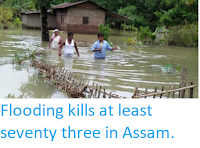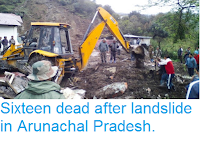Two people have been injured following a major landslide that hit the NH-415 highway between Itanagar and Naharlagun at about 5.45 am local time on Wednesday 17 July 2019. Local authorities initially feared the number of people involved would be far higher, due to a large number of vehicles buried beneath mud and rock at the site, though it subsequently emerged that the majority of these were vehicles parked by the road, many of them associated with a local car dealership. Both of the injured persons are being treated at the Ramakrishna Mission Hospital in Itanagar.
Vehicles hit by a landslide in Arunachal Pradesh, India, on 17 July 2019. EastMojo.
The incident is the latest in a series of such events in the state associated with heavy rains caused by the summer monsoon. Landslides are a
common problem after severe weather, as excess
pore water pressure can overcome cohesion in soil and sediments,
allowing them to flow like liquids. Approximately 90% of all landslides
are caused by heavy rainfall. Arunchal Pradesh has a monsoon season that
begins around the end of April or beginning of May and ends around
September, bringing 2-4000 mm of rain to the region each year.
Autorickshaw hit by a landslide in Arunachal Pradesh, India, on 17 July 2019. EastMojo.
Monsoons
are tropical sea breezes triggered by heating of the land during the
warmer part of the year (summer). Both the land and sea are warmed by
the Sun, but the land has a lower ability to absorb heat, radiating it
back so that the air above landmasses becomes significantly warmer than
that over the sea, causing the air above the land to rise and drawing in
water from over the sea; since this has also been warmed it carries a
high evaporated water content, and brings with it heavy rainfall. In the
tropical dry season the situation is reversed, as the air over the land
cools more rapidly with the seasons, leading to warmer air over the
sea, and thus breezes moving from the shore to the sea (where air is
rising more rapidly) and a drying of the climate. This situation is
particularly intense in South Asia, due to the presence of the
Himalayas. High mountain ranges tend to force winds hitting them
upwards, which amplifies the South Asian Summer Monsoon, with higher
winds leading to more upward air movement, thus drawing in further air
from the sea.
Diagrammatic representation of wind and rainfall patterns in a tropical monsoon climate. Geosciences/University of Arizona.
See also...
Follow Sciency Thoughts on Facebook.









